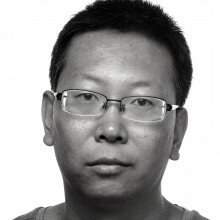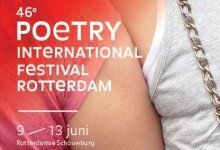Qin Xiaoyu
(China, 1974) Nederlands ►

© Pieter van der Meer / Tineke de Lange
From real estate to an Arcadian landscape, from a yurt to a bank building, for Qin Xiaoyu that is all a small step since he is capable, in the space of a single poem or even a single stanza, of bringing together totally different worlds. Both the urban environment of present-day China and the landscapes that he recalls from his youth come to form the backdrop to his original but often also critically observant poems.
Take for instance his ‘The aesthetics of the Bank of China tower in Shanghai’ in which he writes:
The Whampoa River’s turnover supplies
the remainder of the lower reaches, is the sunset’s molten gold
Ferryboats scatter spindrift like productivity
the flight of sparrows, tortuous as trade
the remainder of the lower reaches, is the sunset’s molten gold
Ferryboats scatter spindrift like productivity
the flight of sparrows, tortuous as trade
Through the characters that pass through his poems – he frequently writes of someone who is walking, who is going somewhere – resonate experiences from Qin Xiaoyu’s (1974) youth. He spent the early years of his life as a shepherd boy with his grandfather in a small village in Inner Mongolia. When he was seven years of age he went to live in Hohhot with his poet father who imbued him with a love of regional folk songs and poetry in general. This personal side of his own past becomes very visible in poems such as ‘Hohhot’, the ‘Badain Jaran desert’ and ‘Night’.
At secondary school he developed a fascination for classical Chinese poetry, a fascination which can often be identified in his work such as in the poem ‘Li Bai and Du Fu’ where the work of the two individuals alluded to is typified on the basis of two statues seen in a museum – a type of poetry writing that likewise prevails in classical verse; or such as in the poem ‘At the Sea of Loneliness’ which constitutes a modern rendering of a poem with the same title derived from work by the thirteenth-century poet Wen Tianxiang. Reason enough for the 2013 publication of a new collection of his on ‘Present-day classical Chinese poems’ to appear.
Apart from writing his own poetry Qin Xiaoyu has, for many years, written about the poetry of others. There the style adopted varies from providing more light-hearted, random notes to accompany the poems (a type of poetry criticism that was fairly common in traditional times in China but which is seldom adopted in modern poetry) to providing longer analyses of a more scientific nature. Together with Yang Lian he compiled an anthology of present-day Chinese poetry that has been translated into English by W.N. Herbert and Brian Holton and which was published under the following title Jade Ladder: Contemporary Chinese Poetry (2012).







